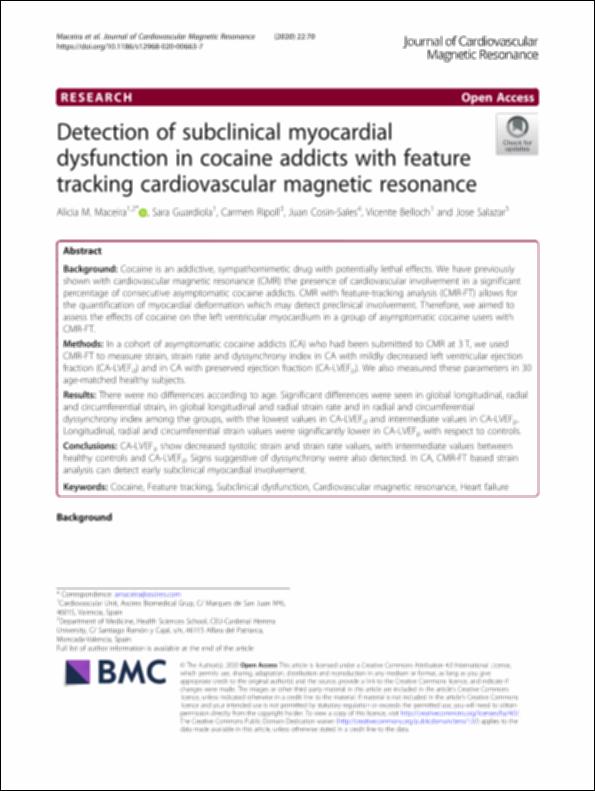Please use this identifier to cite or link to this item:
http://hdl.handle.net/10637/12727Detection of subclinical myocardial dysfunction in cocaine addicts with feature tracking cardiovascular magnetic resonance
| Title: | Detection of subclinical myocardial dysfunction in cocaine addicts with feature tracking cardiovascular magnetic resonance |
| Authors : | Maceira González, Alicia M. Guardiola Vila, Sara Ripoll Alandés, Carmen Cosín Sales, Juan Belloch, Vicente Salazar Fraile, José |
| Keywords: | Miocardio - Enfermedades - Imágenes por resonancia magnética.; Myocardium - Diseases - Magnetic resonance imaging.; Cocaine abuse - Pathophysiology.; Heart failure - Magnetic resonance imaging.; Cocaína - Adicción - Efectos patológicos.; Insuficiencia cardíaca - Imágenes por resonancia magnética. |
| Publisher: | Springer Nature. |
| Citation: | Maceira, A.M., Guardiola, S., Ripoll, C., Cosin-Sales, J., Belloch, V. & Salazar, J. (2020). Detection of subclinical myocardial dysfunction in cocaine addicts with feature tracking cardiovascular magnetic resonance. Journal of Cardiovascular Magnetic Resonance, vol. 22, art. 70 (28 sep.). DOI: https://doi.org/10.1186/s12968-020-00663-7 |
| Abstract: | Background: Cocaine is an addictive, sympathomimetic drug with potentially lethal effects. We have previously shown with cardiovascular magnetic resonance (CMR) the presence of cardiovascular involvement in a significant percentage of consecutive asymptomatic cocaine addicts. CMR with feature-tracking analysis (CMR-FT) allows for the quantification of myocardial deformation which may detect preclinical involvement. Therefore, we aimed to assess the effects of cocaine on the left ventricular myocardium in a group of asymptomatic cocaine users with CMR-FT. Methods: In a cohort of asymptomatic cocaine addicts (CA) who had been submitted to CMR at 3 T, we used CMR-FT to measure strain, strain rate and dyssynchrony index in CA with mildly decreased left ventricular ejection fraction (CA-LVEFd) and in CA with preserved ejection fraction (CA-LVEFp). We also measured these parameters in 30 age-matched healthy subjects. Results: There were no differences according to age. Significant differences were seen in global longitudinal, radial and circumferential strain, in global longitudinal and radial strain rate and in radial and circumferential dyssynchrony index among the groups, with the lowest values in CA-LVEFd and intermediate values in CA-LVEFp. Longitudinal, radial and circumferential strain values were significantly lower in CA-LVEFp with respect to controls. Conclusions: CA-LVEFp show decreased systolic strain and strain rate values, with intermediate values between healthy controls and CA-LVEFd. Signs suggestive of dyssynchrony were also detected. In CA, CMR-FT based strain analysis can detect early subclinical myocardial involvement. |
| Description: | En Journal of Cardiovascular Magnetic Resonance. New York (Estados Unidos) : Springer Nature. Vol. 22, art. 70 (28 sep. 2020). ISSN 1097-6647. e-ISSN 1532-429X. Este artículo se encuentra disponible en la siguiente URL: https://jcmr-online.biomedcentral.com/articles/10.1186/s12968-020-00663-7 |
| URI: | http://hdl.handle.net/10637/12727 |
| Rights : | http://creativecommons.org/licenses/by/4.0/deed.es |
| ISSN: | 1097-6647. 1532-429X (Electrónico). |
| Issue Date: | 28-Sep-2020 |
| Center : | Universidad Cardenal Herrera-CEU |
| Appears in Collections: | Dpto. Medicina y Cirugía |
Items in DSpace are protected by copyright, with all rights reserved, unless otherwise indicated.


